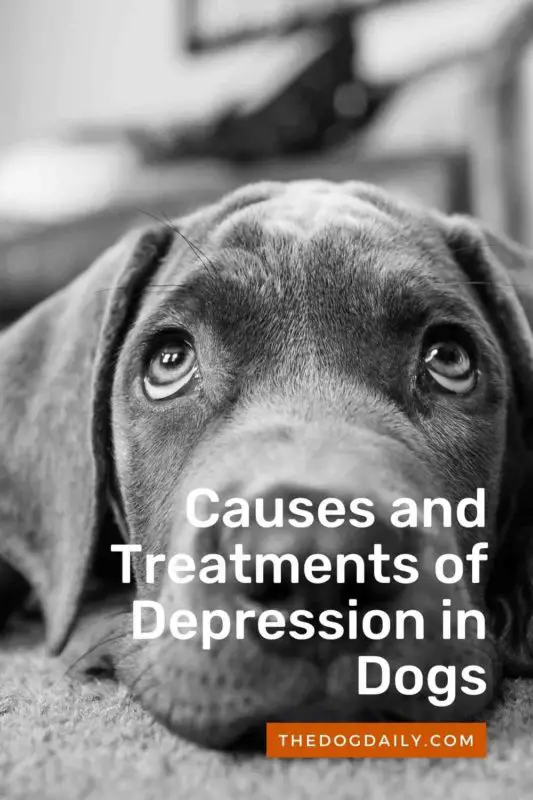Dog Depression
George and Fritz — two canine littermates — spent their entire lives together. In the mornings, they squabbled over the tastiest bowl bites. Sufficiently fueled, they then seemed to collaborate on creative schemes, like stealing tennis shoelaces or sneaking into forbidden places. They went on walks together, played, and napped side by side.
This went on for 14 years until Fritz died. Suddenly, George no longer acted like the same dog. He slept more, withdrew from social activities, and lost interest in his food.
At that point, a visit to the vet was in order. “In such cases, I always begin by looking for a physical cause,” said Dr. Raymond Van Lienden, DVM, a veterinarian at The Animal Clinic of Clifton, Va. “I conduct a full examination, do the blood work, run x-rays and analyze the dog’s complete health history to see what may be wrong.” He added that no physical malady might show up in the barrage of medical tests for dogs like George. “It’s then that we have to look at other possible causes, including grief and depression.”
Is Dog Depression Real?
Dr. Van Lienden says that no study has yet unequivocally proven that depression exists in dogs, but he is convinced animals have emotions. “When you come home, your dog may appear happy and excited to see you, and when you scold it, it may slink away with apparent guilt,” he said, adding that dogs appear to suffer from physical as well as emotional pain. A recent University of Portsmouth study further found that pet owners observed emotions like pride, embarrassment, shame, and even jealousy in cats, pigs, horses, rabbits, rats, and hamsters, as well as dogs. Since mammals appear to experience comparable emotions, depression could be added to the list.
The challenge in diagnosing depression is that symptoms mimic those for many other health problems. These symptoms may include lethargy, weight loss, lack of interest in food, drink, social activities, and a tendency to sleep more. Medical examinations are critical to rule out health problems that may include anything from a chemical imbalance to a thyroid-related condition.
Causes for Depression in Dogs
According to Dr. Van Lienden, change is usually at the root of canine depression. As for George, the change could be sudden death, or other disappearance, of a valued dog or human companion. It might be an unwanted change of scenery, such as when the owner moves from one location to another. Or it could be an unwanted addition, like a new baby, pet, or housemate, that has altered the dog’s routine in some way.
Dr. Van Lienden offered these suggestions for preventing and treating depression in your dog:
- If some kind of significant change is forthcoming, try to gradually transition your dog by maintaining its usual schedule and keeping familiar toys and objects at hand/paw. Then slowly introduce your dog to the new person or place, allowing it to sniff and investigate as much as possible.
- If another dog in your family dies, consider replacing it with a new dog, as studies suggest canines enjoy having same-species companionship.
- Once your vet rules out medical conditions as a cause for your dog’s problems, say something like, “Humor me, doctor. Could my dog be depressed?” Some vets are more open to the possibility than others, so you may have to step in as your dog’s mental health advocate.
- In severe cases, consider medications that your veterinarian could prescribe, such as Prozac, which can “buy some time” to get your dog through the worst period.
The good news is that, unlike humans, dogs live more for the moment. Although grief and depression can linger for weeks or even months in canines, the feelings and related symptoms are usually temporary. “Most dogs will overcome the problems on their own,” said Dr. Van Lienden. “It may just take a bit of time for them to cope and adjust.”
While depression is not recognized as a medical condition in dogs, that doesn’t mean that your dog cannot have depressive symptoms. Symptoms of dog depression may indicate a more extensive medical condition and should be monitored carefully.
What Are The Symptoms of Depression in Dogs?
The main things that usually alerts owners to their dog being unhappy are changes in behavior. Dr. Leslie Sinn, DVM, CPDT-KA and member of the Virginia Veterinary Medical Association, explains: “This could mean that the dog is not interacting the way she usually does, or not engaging the way she normally does. It might include not wanting to go for walks or not eating meals.”
If these behaviors last more than a day or two, they can indicate a medical problem, and you should bring your dog to the veterinarian to run tests.
What Else Can Cause Behavior Changes in My Dog?
Many older dogs can exhibit symptoms that seem like depression but turn out to be something else. “A big concern is untreated pain, which can mirror depressive symptoms,” says Dr. Sinn. “In our older dogs, for example, we worry a lot about untreated pain, such as arthritis. These symptoms could mirror ‘depressive’ symptoms, but point to a much greater and more dangerous condition.”
What Do I Do If My Dog Is Lethargic?
In particular, one symptom that is often mistaken for a depressive symptom is an increase in lethargy. Before bringing your dog to the veterinarian, try to engage him in activities that he previously enjoyed, like fetch. Sometimes, one-on-one time with you might be all your pup needs to cheer up. If this doesn’t work, consult your veterinarian to rule out medical problems.
Depression and Appetite in Dogs
It’s also essential to monitor your dog’s appetite. “If the animal is feeling very poorly and refuses to eat for an extended period, that would put their decline ahead of schedule and is considered very harmful,” warns Dr. Sinn. “If a pet is refusing to eat for an extended period, this could be a serious problem.”
While many scientists now acknowledge that dogs and other mammals experience some emotions, such as disgust, anger, fear, and even happiness, other behaviors’ emotional roots are not as clear-cut. For example, is your dog showing sympathy when you’re crying by laying its head on your lap, or is it seeking comfort from you? Attributing human emotions to canine behaviors can be tricky.
That’s especially true concerning canine behavior that seems to suggest depression. Although clinical depression is a recognized condition in people, veterinary behaviorists aren’t sure that such a condition exists in dogs. “We don’t know for sure whether dogs get clinical depression — but they can act depressed,” says veterinary behaviorist Gary Landsberg of Thornhill, Ontario. Behaviors that appear to reflect depression in dogs include:
- A decrease in appetite.
- Less interaction with their owners.
- Refusing to engage in everyday activities — such as play and training — and generalized lethargy.
Whether or not dogs acquire clinical depression, we should still take steps to deal with behaviors that indicate such conditions. Here’s what Dr. Landsberg and other experts suggest:
-
See a Veterinarian
A dog’s depression-like behavior often signals the onset of a physical illness. “The No. 1 sign of many medical problems in dogs is a change in behavior, such as going off food, interacting less with owners, and reacting less to stimuli,” warns Dr. Landsberg. “Unless those behaviors are associated with dramatic changes in the household, they’re likely to be a sign of medical illness. Have a veterinarian check your dog over.”
-
Anticipate
The changes mentioned above in the household, particularly the death or departure of an individual in the home, can trigger dogs’ depression-like behaviors. This can also happen after a new household member’s arrival, such as a baby or additional pet. Even moving to a new home can cause canine mood changes. “You can prevent depressed behavior if you realize there’s going to be a change in the household,” says Dr. Landsberg. “Gradually adapt the dog to what the change will be like beforehand.” For example, if a child in the family is leaving for college, have someone else take over the dog care duties assigned to the child before he or she goes.
-
Take Care of Yourself
Often a dog may appear to be depressed in response to similar behavior in its owner. For example, if an owner has a depressive condition, such as Seasonal Affective Disorder (SAD), “the dog may act depressed in response to the human,” points out Dr. Landsberg. “And if the owner doesn’t exercise and the dog doesn’t get enrichment as it gets during warmer weather, the dog might become depressed due to change in routine.” The remedy here: Deal with your low spirits first so that you can then take care of your dog.
-
Let Your Dog Help You
If you’ve got the blues, just taking care of your dog can help you deal with them. “The depressed person should help himself or herself, but let the dog help them as well,” says Dr. Landsberg. “Don’t bring the dog down — let the dog pull you up.”
Anxiety in Dogs
New stressors in a dog’s environment can bring on anxiety as well. “There are several things the owner can do to help lower stress, including:
- keeping the dog away from crowded situations
- decreasing chaos and unscheduled activities in the home
- providing the pup with toys, walks, and an increase in one-on-one interaction,” recommends Dr. Sinn.
If these changes do not work on your dog, there are medications that your vet can give your dog to help with the anxiety.
The keys to stopping depressive symptoms in your dog are very similar to what you would do for a sad person if there are no real medical problems. Increasing positive interactions and decreasing chaos and stress will have your dog playing and running around in no time.
Article written by Author: Susan McCullough, Stacey Brecher, and The Dog Daily Expert

